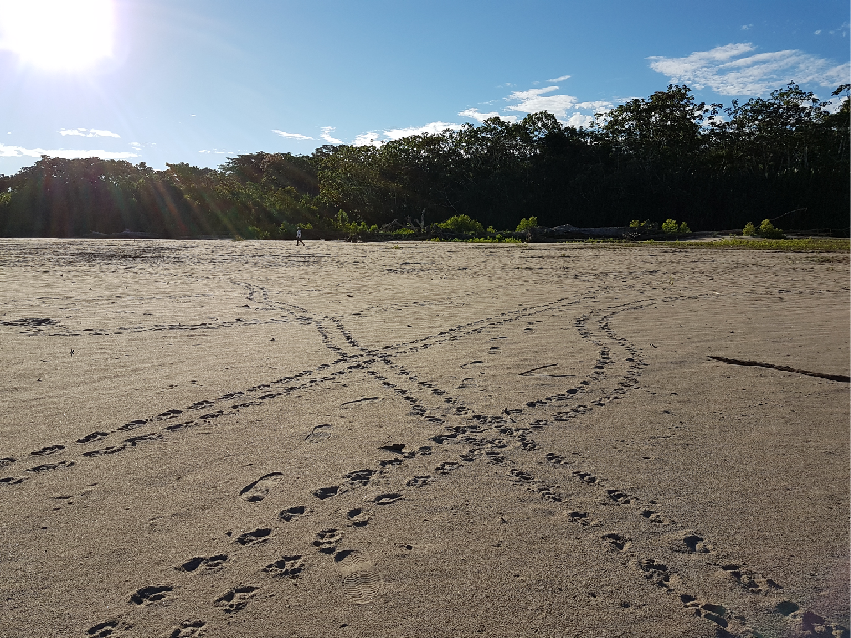There are around 335 species of turtles in the world, which play an important role in the riverine ecology, economy and sociology of many human cultures. Historically they have been highly appreciated and used by indigenous peoples as food, medicinal and cultural resources from around the world. Recently, high demands and those that are alien to their immediate environment have led to an intensive use, drastically reducing the range of distribution of many species and the size of their populations. Today, around 40% of them are listed in some category of threat in the Red List of the International Union of Conservation of Nature (IUCN), and constitute the group of vertebrates with the highest percentage of species that have some degree of threat.
Podocnemis unifilis or “taricaya” is one of these species, which, although having widely distributed populations in the Orinoco and Amazon basins, is in a vulnerable state according to the IUCN and is listed in Appendix II of the International Convention on Trafficking of Endangered Species (CITES). This turtle has been used for more than several hundred years by different native communities of the Peruvian Amazon, including those of Manu National Park (MNP), in southeastern Peru.

Recent initiatives to support the timely sustainable socioeconomic development of the Matsiguenka communities that live within MNP have led to an increase in fluvial traffic from the interior of the Park to nearby commercial towns, such as Puerto Maldonado, capital of the department of Madre de Dios and cradle of deforestation and illegal gold mining, thus shortening distances, making it less remote and inevitably opening up the possibilities of illegal trafficking of species, including taricayas.
In the southeast Amazon of Peru, in Manu National Park, the first studies on taricayas were carried out during the 1990s. These studies documented the time of egg laying and hatching in the years 1990, 1991, 1993 and 1994, and identified the harvest of eggs by people and the early flooding of beaches as the main causes of mortality in P. unifilis. Despite being a protected natural area, the harvest of taricaya eggs was significant, reaching more than 50% of the total nest production, according to studies by Mitchell & Quiñones, 1994, and Landeo in 1997.
Mitchell & Quiñones (1994) suggested guidelines that included measures to ensure that Matsiguenka inhabitants within the PNM had sustainable access to this resource. These measures included strict protection and annual monitoring of the beaches identified as very important, as well as a solid educational component, among others. Regrettably, no further monitoring was done and 20 years later, the status of taricayas populations was unknown, not to mention that no educational program was implemented.
Recently, Manu National Park and San Diego Zoo-Peru Global conducted a study on taricaya populations, which concentrated on an important section of 154 km of the Manu River (Tourist Use Zone), and although the preliminary results of this study seem encouraging — there were 1165 to 1521 adult turtles during the censuses of 2017 and 2018 respectively, and 1457 nests on beaches in 2017, values similar to those found in by Landeo (1994) and Mitchell and Quiñones (1997) — it is not possible to conclude whether the taricaya population is stable or not. We will continue to monitor, but more importantly, SDZG-Peru will integrate for the first time the exploration of the Special Use Zone of Manu National Park, an area where the Matsiguenka communities of Manu are established and the use of this resource is allowed.

The “Taricaya Manu” Project, executed as part of the “Landscape Purús Manu” (PPM) Project, has the possibility of proposing a comprehensive and community management tool, and has great educational potential, since it promotes the implementation of a plan for joint management between the native population and MNP to establish a better system of monitoring and sustainable use of a resource as sensitive as the taricaya. The Manu River basin lies adjacent to other basins also located within protected natural areas that vary in the degree of restriction and external demand on the use of resources, and presents an opportunity to lay the foundations for comparative studies, and consolidate strategies for management and use according to the natural and socioeconomic context at the regional level.
Scope of impacts. The Taricaya Project in general involves non-formal training in the use of equipment such as GPS, compass, clinometer, and camera and video, for members of the team, biologists and Matsiguenka residents, but above all training in the systematic collection of data relevant to the different phases of the reproductive period of P. unifilis. At the same time, researchers outside the local reality learn from the most experienced local inhabitants, to recognize traces of the presence of turtles and important aspects of their natural history. This phase of the project also includes implementing a ‘festival’ of one day of educational activities related to taricayas, including talks about the life cycle, games that strengthen their knowledge using matsiguenka vocabulary, among others.
